Let’s make no mistake about it: Dovetail is a fantastic customer repository tool for those that know how it works – and those who have money to burn. Unfortunately, that leaves the vast majority of us searching for a Dovetail competitor that’s cheaper and easier to grasp.
We still want a customer knowledge base that allows us to store all our user research data in one place. A place that’s simple to navigate so that we can share the research easily, and scalable, so we can continuously uncover new insights. We just also want it to be free and easy to understand…
Does ‘more for less’ sound too good to be true? Is it too much to ask for a decent repository that doesn’t cost the earth, and maybe an applause when you finish work?
@tldv.io Too kind! Too kind! #product #productmanagement #startup #applause #comedy
♬ original sound - tldv.io - AI Meeting Recorder
It’s not. This list of free Dovetail alternatives will provide you with more than enough options to get more for less.
But first, is Dovetail worth it?
Is Dovetail Worth It?
There’s no doubt about it: for the right team, Dovetail is a powerhouse of a tool. Some would even argue it’s one of the best in the business.
However, in the wrong hands, Dovetail can be a massive waste of money. That’s not even mentioning the time spent learning how the software works. It’s not easy, unfortunately.
Pros and Cons
It has a ton of positive aspects:
- Store all your research materials in one place and visualize them easily with journey maps and more
- Discover research patterns in Dovetail’s powerful insights repository
- Easy to export data
- Unlimited storage for recordings, files, notes, photos, and reports of any kind
- Create professional research reports in mere moments
- Collaborate with multiple users and make use of flexible annotation tools
Unfortunately, Dovetail isn’t all sunshine and rainbows.
Here are some of Dovetail’s downsides:
- Complex to learn so it’s not great for convincing stakeholders outside of user research
- User interface is not as intuitive as it could be
- If the insights feature doesn’t suffice, you’ll find yourself using another tool just as much
- Meetings need to be downloaded from an external recorder, then manually uploaded into Dovetail, taking up valuable time (tl;dv has recordings and transcripts available as soon as the meeting ends and can be uploaded with a simple copy/paste)
- You must wait for the transcription to be generated, and there are no speaker tags or highlights (tl;dv’s speaker tags are added automatically and highlights are super easy to create)
- Limited file types: audio, video, and images are able to be uploaded but this may not cover all types of research
- Its hefty price tag can put a stop to most businesses
As you can see, that’s quite a few cons for such a pricey software.
Dovetail Pricing
You can use the basic Dovetail package for free, however it’s unlikely to be of any substantial use.
Free Plan Features
- Unlimited projects
- 3 transcription hours per month
- For individuals only
Of course, this plan is great for getting to know the software before committing to a paid plan, but there are far better free plans available. And the paid plans can be rather extortionate…
If you want to take the business plan for 15 users, it’ll set you back a whopping $900 per month. Enterprise will far surpass that, depending on how many employees you have that will be using the software.
In these economically difficult times, companies want to maximize the value of user research insights while keeping costs to a minimum. That’s why we’ve created this list of Dovetail alternatives. We’ll cover two types of Dovetail competitor:
- Dovetail alternatives that are more affordable – or free!
- Dovetail alternatives that are more appropriate for non-UX people, therefore easier to use across the entire company
These two types of competitor cover the main limitations of Dovetail and seek to remedy them with other UX research repositories.
To Specialize or Not to Specialize
Whether you go with a specialized UX repository (such as Dovetail) or you use a multi-purpose platform as your customer knowledge base (such as Notion or Confluence) – intuitiveness, onboarding, and ease of adoption are key if you want user insights to have a bigger impact across your organization.
This is where Dovetail is lacking. In being so specialized, non-UX stakeholders are likely to be excluded from all that juicy research. And then what good is it?
Making your research easily accessible to those who will be making the decisions is a critical step in the user research journey. By picking software that stakeholders can’t access (like Dovetail, most likely), you’re making your job a lot harder than it needs to be.
Bonus Tool for Improving ALL Research Repositories
Before we get started with the list of Dovetail alternatives, we have to show you a way that you can save time, energy and money, no matter which customer repository you decide to use.
It’s called tl;dv.
tl;dv – The Must-Have UX Research Tool
tl;dv is a remote UX research tool that’s specifically designed to save you time by simplifying the recording, storing, analyzing and sharing of user interviews in video format.
Gone are the days where you have to write copious notes, trying to capture insights as they happen with nothing but a pen and paper. tl;dv’s notetaker for Google Meet and Zoom allows you to type up notes and mark specific times in the video like bookmarks. Even more impressive, these timestamps can be shared directly with stakeholders or designers in a simple click to provide them with unbiased insights straight from the voice of the customer.
Prefer automated notes? tl;dv’s got you there too. Its powerhouse of an AI can generate automatic notes as the meeting progresses, summarize the meeting at the end, or even create sharable highlight reels from footage of your call!
tl;dv lets you capture the emotion and needs of your users in the most accurate way possible – in their own words. It’s never been easier to analyze user feedback and plan accordingly. Simply partner tl;dv with your UX research repository of choice, and quickly and easily store all your favorite clips from user interviews so that you can jump back and rewatch whenever you want.
Not only is tl;dv super intuitive, easy to adopt, and it seamlessly integrates with all your existing work platforms like Slack, Notion, and Google Docs, it’s also available for FREE! Check out its freemium plan here, which includes unlimited recordings, transcriptions, highlights and timestamps.
What’s the Catch?

The catch is the gut-wrenching feeling you’ll have when you realize you haven’t been using tl;dv the entire time.
Just thinking about all those hours wasted manually exporting video recordings, waiting patiently for transcriptions to generate, then tirelessly adding speaker tags and labeling all the crucial insights, only to discover that tl;dv does all this automatically and within seconds… Well, let’s just say it’s too much for some people to handle.
Don’t be one of those people.
Top 5 Dovetail Alternatives
1. EnjoyHQ
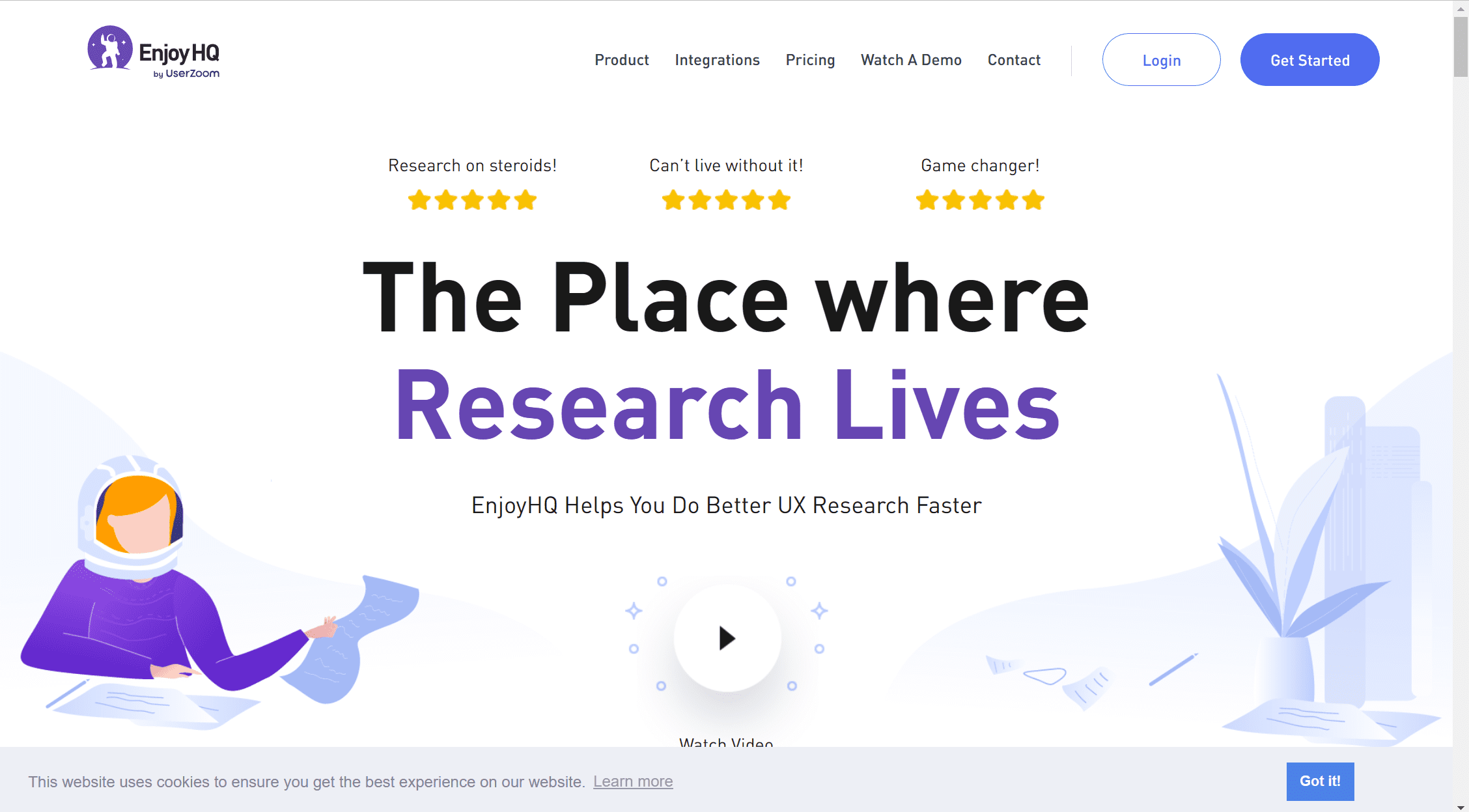
EnjoyHQ aims to solve the problem of customer feedback. It can be difficult to make sense of, especially when fragmented and spread across multiple systems and teams. EnjoyHQ is a customer knowledge base to gather all user research and finally understand with clarity what your customers have been saying. It makes customer feedback easy to search, organize, and share with your team.
"I describe EnjoyHQ as a place of truth, the place where research lives."
Genevieve Kelly - Product Designer, and Lead UX Researcher at Proposify Tweet
Pros
- Top-of-the-range customer service
- Powerful search engine with flexible filters
- All research data available in one location
Cons
- Can be quite complex to learn, making some features unusable, and making it unlikely for stakeholders to have easy access to your findings
- The cheapest paid plan is $1,000 per month
- Recordings must be manually uploaded, transcriptions take time to generate, and you’ll have to manually label insights from user interviews
Pro tip: download tl;dv for Zoom or Google Meet to record, transcribe, download, upload, and timestamp videos rapidly and automatically.
Pricing
As mentioned in the cons section, EnjoyHQ’s cheapest paid plan is $1,000 per month, which is pretty crazy.
However, they do offer a free plan that blows Dovetail’s measly offering out the water.
Free Plan Features
- 2 Admin seats
- Unlimited Read-Only users
- Unlimited Research Projects
- Unlimited Uploads: Text, images, attachments.
- Data Visualizations
- Unlimited Transcriptions
- Video Editing Features
- Taxonomy Manager
- Integrations: UserZoom, Slack, Zapier, Trello, Jira, Email, Google Drive, OneDrive, Dropbox, Box, and Zoom
For more admin seats and some extra features, you can opt for the Grow plan or the customizable Scale plan. Check them out here.
EnjoyHQ vs Dovetail
It might sound like EnjoyHQ and Dovetail suffer from very similar complaints: expensive paid plans, difficult to learn, and time-consuming when it comes to video recordings without the inclusion of tl;dv’s meeting recorder technology. However, EnjoyHQ’s free plan has enough juicy features to really get stuck in, whereas Dovetail’s simply doesn’t.
If you’re working in a small team (of 2) then it may even be enough.
2. Condens
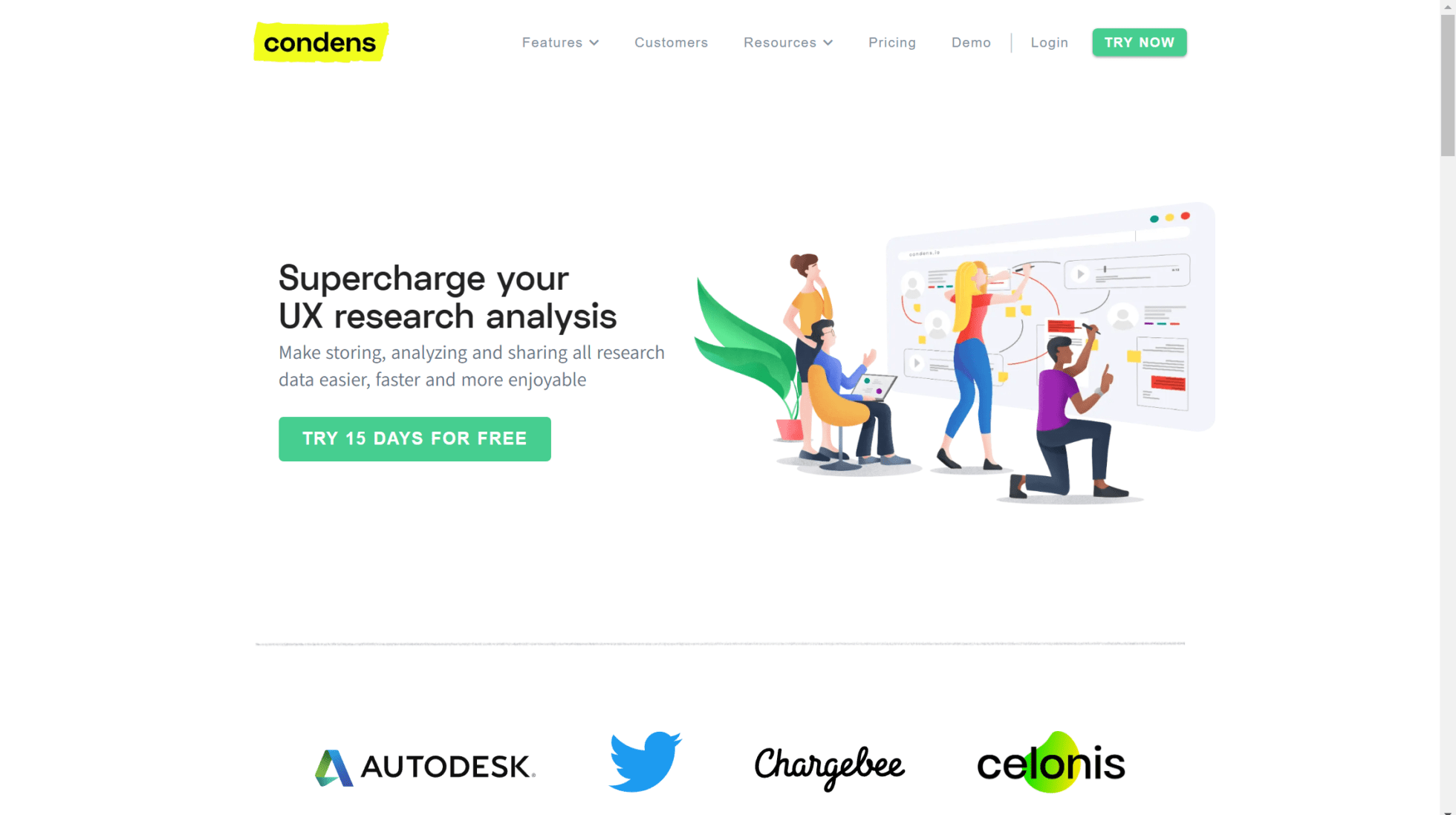
Condens is for you and your team to store, structure and analyze user research data and share findings across your organization. It claims to supercharge your UX research analysis. But does it do it better than Dovetail?
"A great research analysis tool. Easy to use and pretty complete."
Raffaella - Head of Discovery at FifthBeat Tweet
Pros
- Automatic transcription
- Video clips and highlight reels
- Organizing evidence with affinity clusters
- Share your work with clients and stakeholders in one place for easy collaboration
- Conduct user research remotely and reach a larger and more diverse participant base
- Advanced analytics and reporting features for uncovering greater insights
Cons
- No native integrations
- Complex to learn so it’s not great for convincing stakeholders outside of user research
- Meetings need to be downloaded from an external recorder, then manually uploaded into Condens, taking up valuable time (tl;dv’s recordings and transcriptions are instantly available and can be uploaded by copying and pasting)
- You must wait for the transcription to be generated, and there are no speaker tags or highlights (tl;dv’s transcriptions are generated instantly, the speaker tags are added automatically, and highlights are super easy to create)
- Customization is limited
- The tool is not necessarily suited for all types of research projects
- No free plan
Pricing
Condens does not have a free plan. However, it does have a free trial which lasts 15 days. This is enough time to play around with the tool (including all its many features) and learn if it’s the right one for you before committing to a paid plan.
The lowest plan available is the individual plan, currently sitting at $33 per month for one person only.
Individual Plan Features
- One researcher
- 180 hours of automated transcription per year
- Basic integrations
- Unlimited projects and file uploads
- Unlimited sharing of findings in read-only mode
- Personal support and onboarding
From here, the plans leap from $33 to $135, increasing the researcher count up to 5 and unlocking a few extra features. For more information, check out Condens’s pricing.
There is also a project-based plan which is ideal for freelancers. A one-time payment of $50 unlocks several key features for up to 6 months.
Condens vs Dovetail
Condens and Dovetail are similar in many ways. They are both specialized customer repositories and both lack the accessibility to convince stakeholders with their complexity.
Where Dovetail has a free plan with very limited features, Condens has a free trial with all its features. While the 15-day limit may feel constraining, you can really get a feel for Condens’s features by using them before paying.
3. UserBit
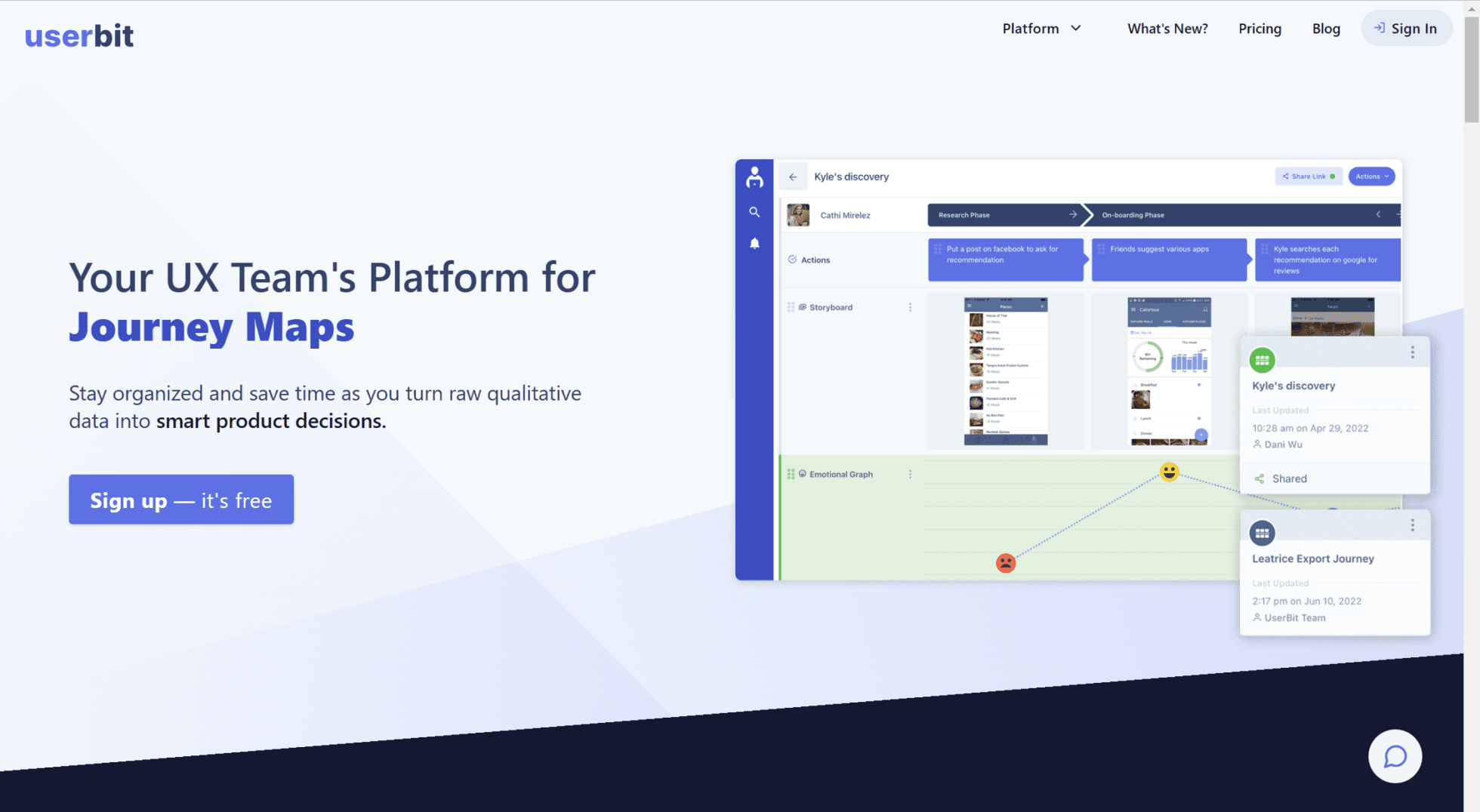
Specializing in journey maps, UserBit is a customer knowledge base platform that empowers you to “stay organized and save time as you turn raw qualitative data into smart product decisions.”
It focuses on collaboration and allows you to work remotely and simultaneously with your colleagues.
"The team is amazing in how responsive it is. The only other time I’ve had fixes so fast was when the developer was literally my husband!"
Crystal Dionysopoulou - Creative Director & Founder, Lucid Fox Tweet
Pros
- Collaborate with your team in real-time from anywhere in the world
- Allows for quick and efficient analysis of text-heavy qualitative data
- Great customer support
- Great for UX designers to store all things UX related
Cons
- Complex to learn and difficult to access for stakeholders who don’t regularly use it
- Meetings need to be downloaded from an external recorder and then manually uploaded (unless you pair it with tl;dv and get instant downloads, and upload with copy/paste)
- You have to wait for the transcription to be generated, and there are no speaker tags or highlights (tl;dv’s transcriptions and speaker tags are automatic, while highlights are incredibly easy to create)
Pricing
UserBit has a fantastic free plan that you can use to get used to the features and understand whether or not you want to purchase the paid version. The first paid plan starts at $60 per month, but if your team is small, you may well be able to make do with the free version.
Free Plan Features
- 1 Repository project
- Participant CRM
- Interview management
- Notes & media
- Survey data analysis
- Tagging & analysis
- Insights & reporting
- 2 Personas
- 2 Journey maps
- 2 Flow diagrams
- 2 Card sort studies
- 2 Visual sitemaps
- Unlimited team members
- 5GB storage
- 2-factor authentication
As you can see, there are a wide variety of features included in the free plan. Unfortunately, they won’t be suitable for larger research projects or customer repositories for larger teams.
UserBit vs Dovetail
UserBit has a stronger free plan than Dovetail, and is perhaps a little more user friendly, however, it’s still built for UX researchers. In this case, it suffers the same fate as Dovetail in that it’s unable to reach the important decision makers of the business.
If your research cannot influence those that make the decisions, then it is essentially useless. By pairing UserBit with tl;dv, you can copy/paste highlights from user interviews directly into your stakeholders’ repository of choice.
4. Dscout
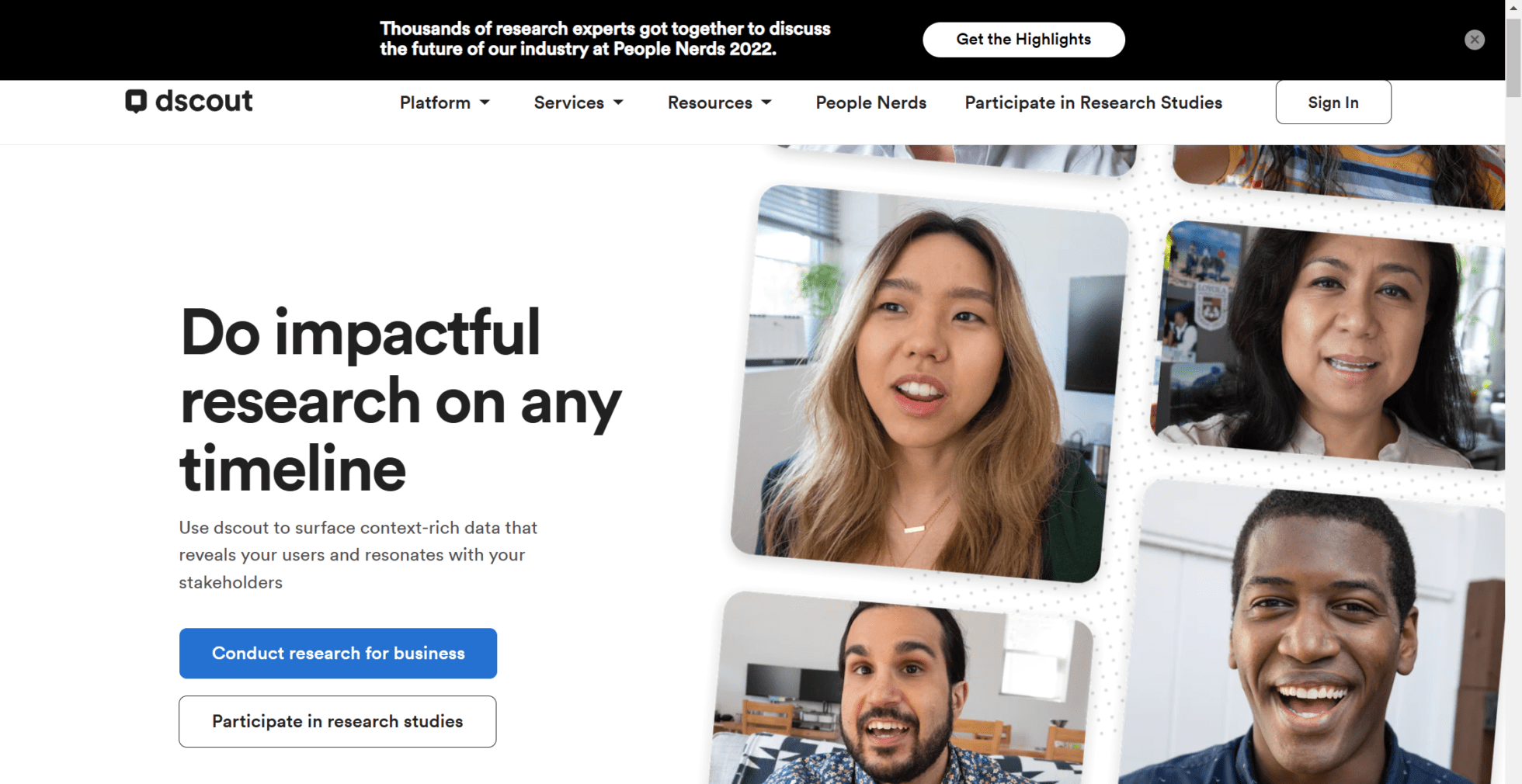
Dscout is a Dovetail competitor that focuses on context-rich data that resonates with your stakeholders. Finally, we have a customer knowledge base tool that acknowledges the importance of influencing stakeholders. But is Dscout the tool for the job?
Let’s find out.
"Dscout helps non-researchers empathize with our users. The platform enables us to capture the voice of the customer and share their perspectives throughout Lenovo."
Dilip Bhatia - Chief Customer Experience Officer at Lenovo Tweet
Pros
- Great way to visualize research data
- Assists with recruiting user participants for studies without the effort and expense of traditional methods
- Helps non-researchers empathize with users
Cons
- Limited to mobile and web apps
- Uploading external video recordings has to be done manually, as do tags to label insights (unlike the copy/paste ability of tl;dv which has AI-generated tags)
- Transcriptions take time to generate (unlike the instant transcripts of tl;dv)
Pricing
For Dscout’s pricing, you’ll need to contact them directly. You can view their features under subscriptions and all plans are customizable.
Dscout vs Dovetail
Dscout definitely solves some of the problems that Dovetail has, however, its price varies from project to project. In a way, this is a good thing as it means you’ll pay for what you need, and nothing extra. However, having to reach out to Dscout for a quote is an additional hurdle that Dovetail doesn’t have.
It has some pretty promising testimonials, but without a free plan to test if it works for your needs, Dscout has missed an opportunity.
5. ProductBoard
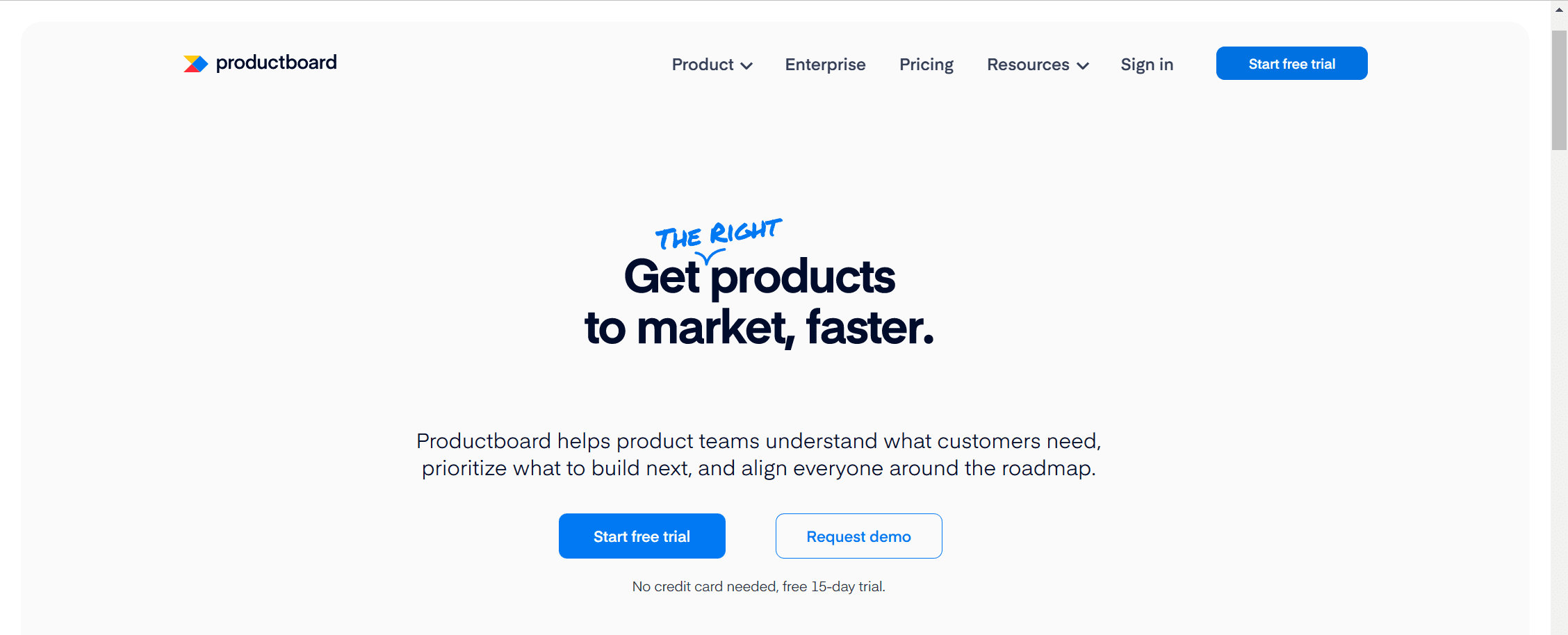
Productboard is one of the easiest to use customer repositories out there, but it’s not a direct Dovetail competitor as its primary focus is on sorting and collecting insights that you gathered elsewhere.
As a product management platform, Productboard helps you get the right products to market, quicker, by understanding the needs of your customers. In doing so, it helps you build priorities and structure, aligning your whole team behind an intuitive roadmap.
"The platform has enhanced our ability to launch products, while gathering the right feedback from our customers. With Productboard, we are able to focus on building the best products for our customers."
Param Kahlon - Chief Product Officer at UiPath Tweet
Pros
- Include insights from many different channels of research, including questionnaire tools, user interviews, and usability tests
- Easily gather and organize customer feedback
- Features for prioritizing and organizing product developmental tasks
- Collaboration tools for async and remote work teams
- Integration with other tools such as Trello and Jira
Cons
- Can be difficult to learn for newcomers, including stakeholders who may struggle to adapt and therefore fail to access your research
- Difficult to customize
- The customer support can be improved
- Can be costly for small businesses
Pricing
Productboard’s free trial allows you to create one roadmap to test some of the features.
Free Plan Features
- 1 flexible and configurable roadmap
- Share with anyone
- Collaborate with unlimited makers
- Google Apps SSO
- Access product makers community
- Collect feedback
It’s a good segue into what Productboard offers, but it’s not enough to work from for long periods of time, or on larger projects.
If you need unlimited products, features, and roadmaps, you can check out the paid plans, starting at $20 per month.
Productboard vs Dovetail
As mentioned above, Productboard is not a direct Dovetail competitor. While it’s definitely one of the Dovetail alternatives, and can be used to create a customer knowledge base, Productboard’s strong suit is in its ability to organize and sort different avenues of user research.
When paired with a product research tool like tl;dv, it becomes a very powerful contender for Dovetail’s throne.
Dovetail Alternatives for Non-UX People
If you break it down to its essence, Dovetail lets you store your user research data in a single location, where you can then share and analyze that research to uncover insights at scale.
While there are plenty of Dovetail competitors that were built specifically for the world of UX, there are a few other tools that you can repurpose into customer knowledge bases. You may even use some of them already, making the onboarding process super simple.
Here are four that everybody has heard of:
These more generic tools share two benefits and one downside between them all.
Pros
- Easily accessible to all your team members, including stakeholders, designers, developers and product teams
- They won’t break the bank – in fact, you may already use them
Cons
- May not be suitable for large UX research projects with specific and specialized requirements
Obviously, for more complex customer repositories, these may not be good enough. If you have large swathes of data, they may be difficult to keep track of in one of these tools, but for smaller or simpler research tasks, any one of these 4 tools could be repurposed into a customer knowledge base and save your company a whole lot of time, money, and effort.
A Final Note
One last thing: a customer repository is not very useful unless you can upload and access your insights clearly and easily.
So regardless of which of the Dovetail alternatives you pick, or even if you’re sticking with Dovetail, you should always record your user interviews with tl;dv.
The recording is available as soon as the meeting ends, the transcriptions are instant, and the speaker tags and insight labels are AI-generated automatically. The recording can be broken down into highlights of the most important insights in an easy and intuitive way, and then shared on ANY platform you use with a simple copy and paste.
Partnering tl;dv with your customer repository of choice is an absolute no-brainer! Especially when you remember it’s completely free…





